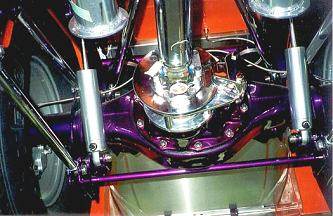
If you are starting a project from the ground up, you will have to deal with coating the undercarriage and the extent you go depends on your intentions with your ride and, of course, your budget (and time). On a daily driver that sits low you may just want to get something on there to keep it from rotting, on a show car where the undercarrige is judged you may put as much (or more) effort into it as the outside or you may want something in between for a go 'n show. Options include chassis enamel, powder coat, acrylic enamels, epoxy, urethanes. The most important thing is to start with clean metal (see article on stripping) as this will effect everything else you do.
Powder coating is a cost effective and very durable way to protect bare metal. The process involves pre-heating, then grounding the metal while an electrostatic powder is applied followed by high temperature curing. Powder is available in different materials and is very strong when compared to conventionally applied (wet spray) materials. During application, powder paint statically jumps around tubes being very effective at coating hard to reach areas evenly making it ideal for a chassis. Since powder can only go on bare metal, the smoothness of the metal will effect the texture of the finish although it fills more than wet paint. Years ago, a friend who does chroming, prepped all the metal parts on his Harley like it was to be chromed but powder coated and it turned out amazingly smooth and glossy. If you are planning on cherrying everything smooth with plastic fillers you will not have powder as an option (won't conduct). We tried the home kit from Eastwood and it works great, however it is only capable of doing small parts, you will need a professional powder coater with a big enough oven to do large areas such as your frame. In the past, the colours available in powder were somewhat limited, however that has improved lately. I recently had a frame powdercoated in a tricoat candy from Tiger Dry Lac and it turned out fabulous. They sell a variety of custom colours (including a simulated chrome!) in small quantities and recommended some shops to perform the work (they are based in Cambridge).

If you are on a tight budget and just want black, there are several chassis enamels available that will go direct to metal with out primer. They are basically a quick dry enamel containing a small amount of etch (like Tremclad) and offer limited corrosion resistance but are easy to touch up and are cheap. A tougher alternative would be an industrial epoxy primer (available in black) followed by an industrial acrylic urthane, these products are designed to be sprayed one right after the other with out sanding and offer very high corrossion and chip resistance.
Automotive finishes such as enamel and acrylic enamel will offer more colour choices and a better gloss (if you sand the primer) but are prone to stone chipping as they are brittle when they cure. Automotive acrylic urethane is a better choice as it is tougher. The true poly urethane paints that are used on trucks and aircraft are even more resilient although pricey and sometimes limited in colour selection. If you are colour matching to the body you may have to use the same material. You must use a suitable primer for the topcoat you choose.

When priming or painting a frame, use lower air pressure than you would normally as the areas are small (easy to wet) and you want to limit runs and dry overspray as you move around (tip - turn in your fluid tip a bit to limit material). Generally you should start at one end and continue non stop around it untill you are finished, paying attention to hidden areas and trying to keep a consistant wet finish with out sags. You waste a lot of product trying to cover everything (a lot goes in the air) so make sure you have enough material. The outside of your ride gets much closer inspection than the chassis so don't fret too much if it is not absolutely perfect (it never is) as you won't see most of it anyway and is not in a lot of light. It is a daunting task getting a chassis pretty but the end result is awesome and will bounce of any plating or polished pieces you add - making both look better.
Good luck
John